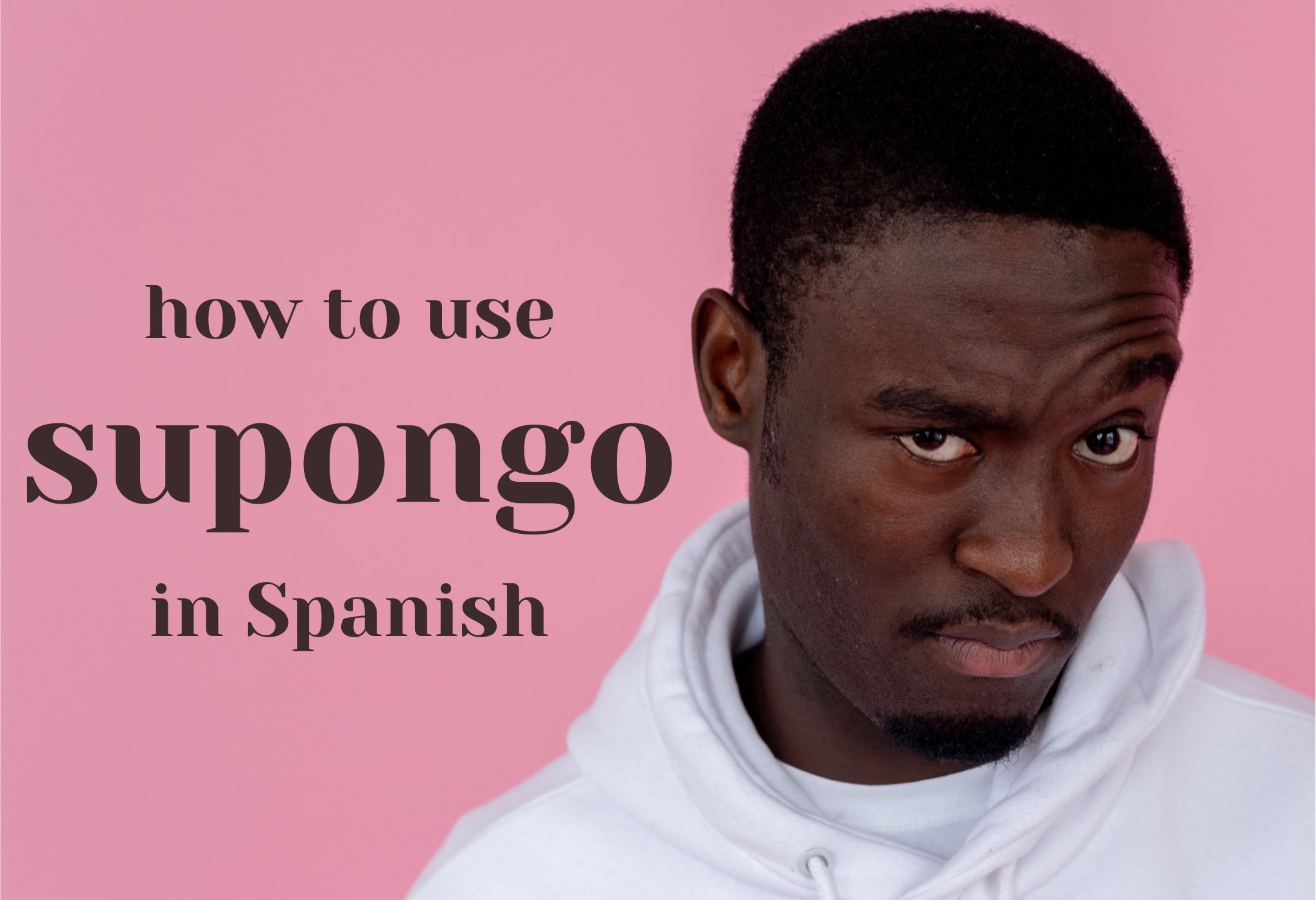Supongo in Spanish: The nuances of this expression of assumptions

Get our free email course, Shortcut to Conversational.
Have conversations faster, understand people when they speak fast, and other tested tips to learn faster.
More infoSupongo is a versatile Spanish word that can be translated into English in several ways depending on the context in which it’s used. Its uses range from expressing a lack of certainty to expressing a guess or an assumption.
Depending on the use, supongo can trigger a variety of tenses in the verb that follows, between the indicative, the conditional, and the subjunctive.
We’ve put together this post to take you through the various uses and meanings of supongo, and to show you how to choose the right tense when you introduce a phrase with supongo in Spanish. Now let’s dive in!
Supongo: Direct translation
Supongo is the first-person singular present tense conjugation of the verb suponer, which means to suppose or to assume.
The easiest translation of supongo is therefore I suppose or I assume. Beginning a sentence with Supongo que is very common when we want to introduce whatever we suppose or assume.
As we’ll see in the next sections, these assumptions can have varying degrees of certainty.
Supongo for a high probability
When we believe something to be very likely, we can introduce it with supongo. In this use of supongo the probability is very high, even if there may remain a possibility that whatever we say might not turn out to be true.
Good translations of supongo in this context include I assume, I presume, presumably, and in all likelihood.
- Con un cielo así, supongo que va a llover. – With a sky like that, in all likelihood, it’s going to rain.
- Supongo que podemos conseguir entradas en la puerta. – I assume we can get tickets at the door.
Supongo for a presumption or an opinion
One of the most common uses of supongo is to introduce something that we’re fairly confident of based on limited information, even if it’s not certain. This use of supongo is a good way to qualify an opinion without necessarily stating it as fact. The best translation here is I suppose.
If you suspect your friend will arrive late because that’s his normal habit, or perhaps because there’s heavy traffic, for example, you could use supongo to introduce this presumption:
- Supongo que llegará tarde. – I suppose he will arrive late.
- Supongo que podemos empezar la reunión sin él. – I think we can start the meeting without him.
Supongo to introduce vagueness
Another common use of supongo is to insert a degree of doubt or uncertainty into whatever you’re introducing. Good translations here include I guess and I imagine.
This use is when you have an idea, but you definitely don’t want to be quoted as on it!
- Supongo que tiene unos 30 años. – I guess he is around 30 years old.
- Supongo que es demasiado caro para nosotros. – I imagine it’s way too expensive for us.
Supongo que no to imply a negative connotation
When we introduce our statement with Supongo que no…, we’re being pejorative. Not only are we expressing doubt about whatever we’re describing, but we’re also conveying our opinion that we’re not so pleased about it.
- Supongo que no me quieres ayudar. – I suppose you don’t want to help me.
- Supongo que no vas a aprobar tu examen. – I guess you’re not going to pass your exam.
In these examples, the speaker is critiquing the other person’s intentions or motives. It’s implied that the first person is not willing to help, and that the second is not studying hard enough.
Supongo que + conditional to make a polite request
In this construction of supongo que + conditional, we’re adding a layer of politeness to a request by suggesting that I assume you would…. This use is common in written communication such as letters or emails in order to soften the tone of a request and make it appear more as a suggestion.
- Supongo que podrías ayudarme con esto. – I suppose you could help me with this.
- Supongo que nos prestarías el coche para el baile de graduación. – I suppose you’d lend us the car for prom.
Suponer que + subjunctive for hypothetical meaning
As we’ve seen so far, supongo que normally triggers the indicative mood. Occasionally, however, the subjunctive mood is used when we want to convey a hypothetical meaning. In these cases, we don’t use the supongo form, and instead conjugate suponer que in either the gerund form or the imperative form.
Here’s an example where we use the gerund form, which is suponiendo:
- Suponiendo que tuvieran suficiente dinero, ¿irían a Europa? – Assuming that you had enough money, would you go to Europe?
Otherwise, we can also form our hypothetical sentence similarly using the imperative:
- Supón que te diera la respuesta ahora, ¿estarías lista para aceptarla? – Suppose I gave you the answer now, would you be ready to accept it?
Keep in mind that the verb suponer just triggers the subjunctive like this when we’re really expressing a hypothesis. Most of the time we use supongo when we’re much more certain of whatever we’re saying, even when there’s room for doubt, so the indicative is the only mood that you’ll need.
Conclusion
As we’ve seen here, supongo is a versatile Spanish word whose uses range from expressing an opinion or assumption to expressing doubt, uncertainty, or vagueness. Common translations for supongo in English are I suppose, I guess, and presumably, with other variations along these lines depending on the context.
In most contexts, even though there’s some degree of uncertainty built into the expression, supongo triggers the use of the indicative mood. However, we also saw that when we want to make a polite request it can be followed by the conditional. Finally, we saw that when we really want to express a hypothesis it can trigger the subjunctive, but in those cases it’s no longer in the form of supongo but rather conjugated to different forms.
¡Supongo que ahora usarás esta expresión! – Presumably, now you’ll use this expression!



